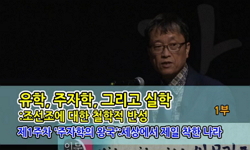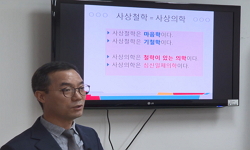이 연구는 최한기가 주자학과 실학적인 전통위에 자신의 학문세계를 구축한 점을 주목하고 니시 아마네의 경우는 일본 고문사학파의 학문, 즉 소라이학적인 전통 위에 학문을 구축하였다는...
http://chineseinput.net/에서 pinyin(병음)방식으로 중국어를 변환할 수 있습니다.
변환된 중국어를 복사하여 사용하시면 됩니다.
- 中文 을 입력하시려면 zhongwen을 입력하시고 space를누르시면됩니다.
- 北京 을 입력하시려면 beijing을 입력하시고 space를 누르시면 됩니다.

사상 : 근대 전환시기 최한기와 니시 아마네의 학문관 비교 = A Comparison between Choi Hangi and Nishi Amane in their Respective Views of Learning
한글로보기https://www.riss.kr/link?id=A101743415
- 저자
- 발행기관
- 학술지명
- 권호사항
-
발행연도
2015
-
작성언어
Korean
-
주제어
최한기 ; 니시 아마네 ; 실학 ; 소라이학 ; 주자학 ; 성리학 ; 한국유학 ; 일본유학 ; 기학 ; 양학 ; Choi Hangi ; Nishi Amane ; Silhak ; Soraigaku ; Neo-Confucianism ; Korean Confucianism ; Japanese Confucianism ; Kihak ; Yougaku
-
등재정보
KCI등재
-
자료형태
학술저널
- 발행기관 URL
-
수록면
47-82(36쪽)
- DOI식별코드
- 제공처
-
0
상세조회 -
0
다운로드
부가정보
국문 초록 (Abstract)
이 연구는 최한기가 주자학과 실학적인 전통위에 자신의 학문세계를 구축한 점을 주목하고 니시 아마네의 경우는 일본 고문사학파의 학문, 즉 소라이학적인 전통 위에 학문을 구축하였다는 점을 주목하여 두 사람의 학문세계를 비교, 고찰하였다. 조선의 실학과 일본 에도시대의 소라이학은 모두 주자학의 문제점을 극복하는 과정에서 발생한 학문으로, 실학은 주자학의 큰 틀과 사상체계를 거부하지 않았으나, 소라이학은 주자학의 패러다임을 정면으로 부정하면서 등장한 사상이다. 즉, 실학은 리와 태극을 중심으로 한 주자학의 형이상학적 담론을 거부하고 실증적이며 현실적인 문제에 관심을 가졌다. 구체적이고 개별적인 사실과 현상에 관심을 가졌다고 한다면 소라이학은 통일적인 원리를 부정하고, 하나의 절대적인 대명제를 거부한다는 점에서 귀납적인 진리의 추구와는 거리가 멀다. 고대에 사용된 어떤 단어의 진정한 개념을 찾아내 그것을 다른 문장을 읽는데 활용하는 일이나, 고대의 진실한 도(道), 즉 선왕의 가르침을 찾아내 그것을 현실의 여러 상황에 대응시켜나가는 일은 연역적 방법이라고 할 수 있다. 최한기와 니시가 각각 실학과 소라이학으로부터 받은 영향은 그 내용보다는 이러한 방법론상의 영향이었다고 할 수 있다. 최한기의 기학은 실용적인 여러 학문을 체계적으로 구축하고자 한 성격이 강하다. 중국의 이학(理學)과 심학(心學)이 거대한 사상 체계를 구축하였듯이 그의 기학도 하나의 대명제를 중심으로 거대한 학문 체계를 조직하고자 하였다. 그러나 니시의 양학은 새로운 학문 체계의 구축보다는 서구 문명의 사상과 학문을 있는 그대로 순수하게 수용, 전달하고자하는 경향이 강했다. 니시가 서양어의 번역에 특히 힘을 썼던 것은 일본사회에 서구 문명의 참모습을 그대로 전하고자 하는 의지가 강했기 때문이다.
다국어 초록 (Multilingual Abstract)
This paper compares between Choi, Hangi``s view and Nishi Amane``s view on learning. Choi, Hangi structured his world of learning upon the academic tradition of Neo-Confucianism and Silhak, whereas Nishi Amane built his scholarship on the tradition of...
This paper compares between Choi, Hangi``s view and Nishi Amane``s view on learning. Choi, Hangi structured his world of learning upon the academic tradition of Neo-Confucianism and Silhak, whereas Nishi Amane built his scholarship on the tradition of Kobunjigaku founded by Ogy Sorai. Both Silhak of Joseon and Soraigaku of Japan were created in the course of overcoming the problems of Neo-Confucianism. However, there is a great difference between the two schools. One did not refused the paradigm or the system of the Confucian philosophy of Song times, but the other aggressively controverted it. Scholars of the Silhak school disapproved of the metaphysical discourse of Neo-Confucianism, and had interests in the realistic problems. They also were concerned about the concrete facts and phenomena. This tendency might be similar to the inductive approach to the truth, or first principles. Those who belong to Sorai school, however, disclaimed a unified principle for the universe, or all creation. Their approach for true principles was a long way from inductive method. It was near the deductive reasoning. The effects to the thoughts of Choi and Nishi from the Silhak and Soraigaku was the method of learning, not the contents. Kihak of Choi, Hangi was a compilation of the various practical studies of East and West. His Kihak aimed at for the construction of the great ideal system focusing on the great principle, as if the Lixue and Xinxue of China did. Yougaku, the western learning, of Nishi Amane, however, intended to grasp the genuine thought and learning of Western civilization and to convey to the society of Meiji Japan just as it was. Consequentially, Nishi gave his best to the translation of Western culture.
동일학술지(권/호) 다른 논문
-
교육 : 『논어』,『맹자』를 활용한 대학 인문고전 교양교육 사례 연구
- 영산대학교 동양문화연구원
- 최윤정 ( Yun Jeong Choi )
- 2015
- KCI등재
-
교육 : 대학 교양과목으로서 논어교과의 효과성에 대한 연구
- 영산대학교 동양문화연구원
- 박진형 ( Jin Hyoung Park )
- 2015
- KCI등재
-
- 영산대학교 동양문화연구원
- 이도현
- 2015
- KCI등재
-
- 영산대학교 동양문화연구원
- 장병한 ( Beoung Han Jang )
- 2015
- KCI등재




 KCI
KCI KISS
KISS






